Hamsters are popular pets for a good reason. They’re easy to care for and, of course, adorable and entertaining. You’ll most likely end up with a teddy bear, or Syrian hamster, as they’re the most popular breed available at pet stores.
So, what do you need to know to care for your teddy bear hamster? Teddy bear hamsters need to live alone in an environment with adequate stimulation, food fit for their nutritional needs, and exercise. With regular veterinary care and careful handling, they can live full, happy lives.
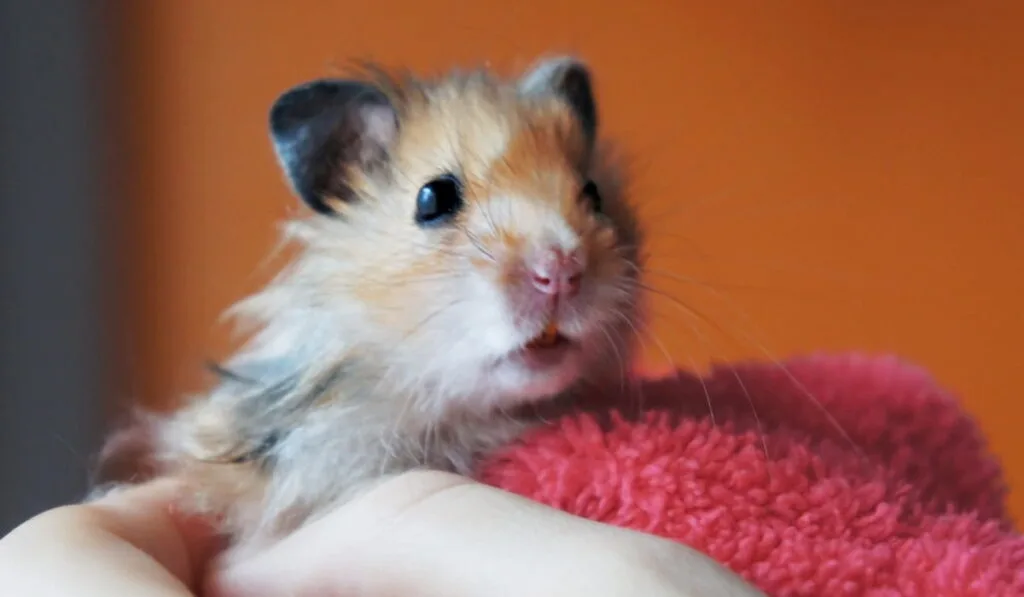
Caring for them is simple, but you’ll need to be well-informed on the nuances of raising a teddy bear hamster versus a dwarf hamster. Even though they have short life spans, they’re a commitment you should be prepared for.
Table of Contents
What Is A Teddy Bear Hamster?
Teddy bear hamsters, also known as Syrian or golden hamsters, are small rodents that originated in northern Syria and Turkey.
The species was nearly endangered until 1930 when a zoologist captured a female and her pups to breed as lab animals. Luckily, the hamsters were also exported to the United States the next year, where they became popular pets.
Generally, they’re five to seven inches long and weigh five to seven ounces, which is larger than other kinds of hamsters. If you’re looking for a smaller hamster, dwarf hamsters are usually smaller by an inch on average.
They can live to be up to three years old with proper care, but live to be around two on average. Though they’re relatively uniform in size, they’re very diverse in terms of their coat colors and textures. Their coats can be:
There are even more colors they appear in. They can be, in order from lightest to darkest:
- White
- Cream
- Golden (the most common)
- Cinnamon
- Sable
- Chocolate
- Gray
- Black
And that doesn’t even include their patterns or eye colors! With all of these options, you’ll surely find a hamster that you like.
However, note that some variations require special bedding and care. For instance, long-haired hamsters require careful grooming and the right bedding to ensure that their fur doesn’t get matted.
What’s A Teddy Bear Hamster’s Temperament?
Teddy bear hamsters are great pets for a reason. A properly cared for teddy bear hamster is docile when handled, but active, especially in the night and evening. They’re little balls of energy and require a lot of stimulation through toys or exercise wheels to stay happy.
If they have a lot of human contact, they’ll enjoy being held. If they’re left alone too much, they tend to nip or bite, mostly out of fear.

They’re pretty smart as well. If you work at it, you can train your hamster to recognize its name and even litter-train itself.
Even though they’re kind to their humans, teddy bear hamsters are definitely not nice to each other. Unlike dwarf hamsters, which can cohabitate, teddy bear hamsters should never live together.
On the less extreme end, they’ll both be stressed and unhappy, and on the opposite end of the spectrum, they’ll injure or kill each other.
The Life Cycle of a Syrian Hamster
The life cycle of a Syrian hamster is essentially the same as other hamsters. Hamsters have incredibly short gestation periods of around two weeks and give birth to litters of between six and ten babies.
When baby hamsters, called pups, are born, they’re totally helpless – their eyes aren’t open, they can’t hear, and they don’t even have fur.
Their eyes don’t open until they’re two weeks old, yet at this point, they’re nearly halfway to puberty. In their time with their mother, they’ll slowly gain independence and explore their surroundings.
They’re fully weaned from their mothers after about a month. For teddy bear hamsters, this means that they’ll need their own space at this point. Being related doesn’t stop them from being territorial and fighting for their space.
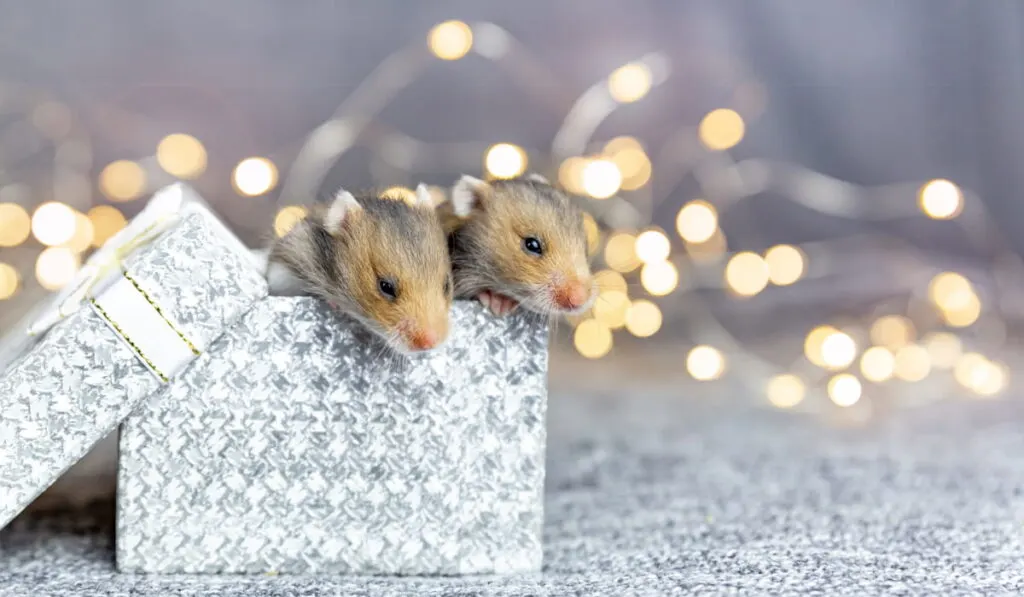
Hamsters are sexually mature between four and six months, but female hamsters shouldn’t breed until they’re at least two or three months old to prevent stillbirths.
As covered above, teddy bear hamsters live to be around two years old, being considered elderly around a year and a half.
Buying a Teddy Bear Hamster
Syrian hamsters are widely available at pet stores, though they might not receive the highest quality care if it’s a larger chain.
Look up breeders in your area if there’s a particular color or temperament you’re looking for. They’ll be able to help you pick the best hamsters for your lifestyle.
Though it might be tempting, don’t pick your hamsters based on looks alone. First, make sure they’re healthy. A healthy hamster has:
- A clean bottom
- Bright eyes
- Clean, short nails
- A lack of discharge from the nose
- Clean, even fur
- All their teeth
Hamsters are also nocturnal, so you’ll likely have to wake one up to get a sense of its personality. An ideal pet hamster is active, docile, and readily handled.
Essential Gear for Your Syrian Hamster
Although they’re easy to care for, hamsters need a good environment to stay happy and healthy. A hamster’s home is one of the most significant factors in their overall well-being and health, so don’t buy the first things you see or opt for the budget version of everything just to save a buck.
First, they need a cage. Even though hamsters are small, they thrive in cages that are at least 24 x 12 inches in size. The cages can be a variety of types, too, like wire-mesh, standard glass with a mesh top, or plastic.
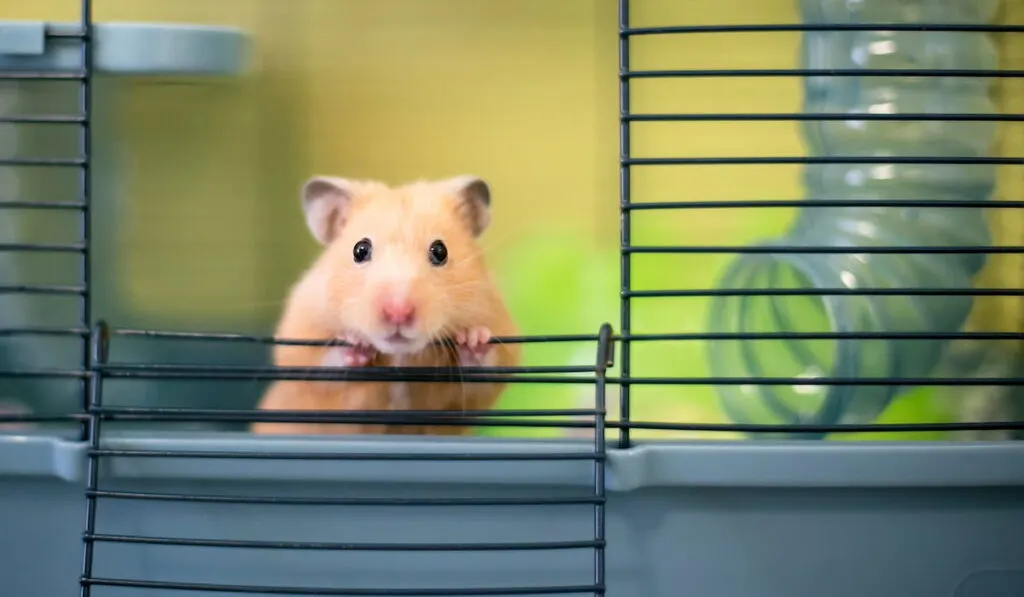
Here’s a good cage that provides a lot of height and is made of mixed materials at a fair price.
Next, you’ll need bedding. Hamsters have sensitive eyes and noses, which makes heavily-scented cedar or pine shavings a poor choice. Opt for paper-based bedding so your hamster can still use its keen sense of smell. You wouldn’t want the hamster to get stressed about moving around their own home without their senses.
You’ll also need a lot of accessories to keep your hamster happy. As I mentioned, hamsters need a lot of stimulation to stay happy, or they might try to plan an escape. But what kinds of things should you buy to keep your pet busy?
Chew Toys
All rodents’ teeth constantly grow, so hamsters need to chew to keep them filed down and healthy. Get your hamster some soft wooden chews to play with. Avoid giving them plastic chews, since they can injure them if they break. This is a cute set that would liven up any hamster cage.
- 🍏Natural and Pollution Free: The bunny chew toys materials are natural materials such as apple wood, wood vine, water grass, etc. It is very suitable for rabbit guinea pig molars, but also as a toy
- 🐰Benefit to Small Pet: Ideal for chewing food, help keeping dental health,they also provide roughage which is good for digestion and may aid in relieving intestinal inflammations and mild pain
- 🐹 Improves Dental Health: The chew toy is good for the teeth and can be chewed safely. Small animals that move teeth must grind their teeth. If they don’t grind their teeth, when the teeth are long, they will fell uncomfortable
Exercise Wheel
Hamsters have a lot of energy that they need to burn off, and exercise wheels are a popular way for them to stay active. Choose an exercise wheel with a diameter of at least eight inches in a solid material like this. Smaller wheels make their backs arch too much, and their feet can get caught in wire-style wheels, both causing serious injury.
- ★ Free Cage Attachment Included ★ – If your pet resides in a wire cage, you will find it helpful to secure the wheel to a wall or ceiling of the habitat. We include detailed instructions with pictures and the necessary accessories to do so.
- ★ Best fit for Sugar Gliders, Hamsters, Small Rats ★ Sorry hedgehogs, you probably need a larger wheel. This wheel is 11” diameter (12 “ with the stand).
- ★ Free Tail Shield ★ We include free wall-to-wall tail shield to protect your pet from injuries.
If you get the right wheel for your hamster, they’ll be entertained for hours. Hamsters can run up to nine miles in a single night!
Tunnel Toys and Hiding Spots
Hamsters love to hide and cuddle up in spots they feel are safe. Many do this in their bedding by pushing piles of it into corners and hiding in them, but providing structures for them to take cover in will make them even happier. Add in extra clumps of bedding in corners of their cages so they can huddle out of sight.
Hamsters make tunnels naturally when they’re in the wild, so having tunnels in their living space will allow them to tap into their natural instincts. You can make tunnels on your own if you’re up for a DIY project. You can make them out of paper towel rolls or empty water bottles so you can decorate them how you wish.
If you’re really into crafts, you can even build your hamster a mansion, as these owners did.
Or, if you’re not into crafts, there are a lot of tunnel options available. Here are a few great ones that your hamster will love:
- Habitrail OVO Adventure Pack
- Niteangel Multi-Chamber Hamster House Maze
- Kaytee CritterTrail Fun-nels Value Pack #4
Just as you did with their cage, make sure the tunnels you buy are large enough for your hamster to move around in.
Feeding Your Hamster
There are tons of brands of hamster food out there, but how do you pick the best choice? Think of it the same way you might think of feeding yourself.
Could you live off of junk food alone and expect to live a healthy, long life? Probably not. The same goes for your hamster.
Pick a brand of food that covers all of their nutritional needs without fillers or additives. Hamsters are omnivores, so choose a food that provides enough protein and other nutrients to make sure they’re adequately fed.
This brand is a good example – it’s all-natural and doesn’t have artificial additives that don’t add anything to your hamster’s life except color.
Hamsters also love treats, especially fruits and vegetables. They can safely eat all fruits and vegetables, excluding citrus fruit, fruits with seeds, avocado, and lettuce–these can be harmful to your pet’s health.

Avoid feeding them too many treats, even if seeing them with their cheek pouches filled with snacks is adorable. Limit them to twice a week to prevent them from gaining too much weight. Give them a small sample of new treats to make sure they digest them well.
Hamsters need clean water daily, as you might have guessed. Since water bowls can be tipped over and make their bedding wet, buy a no-drip water bottle for them to drink from.
Handling Your Hamster
Now that you know what to give your Syrian hamster, you should know how to interact with them to keep them healthy.
Since hamsters are so cuddly, you’ll probably want to hold yours all the time. But don’t get too handsy too fast. First, wash your hands–hamsters are susceptible to colds, just like humans are.
Then, start slowly and gently. Handle them for no more than ten or fifteen minutes at a time, so they learn that being held isn’t the end of the world. Don’t be too rough with them because they’re sensitive to touch.
Since hamsters are nocturnal, make sure you wake them gently by talking to them or making noise before you pick them up. They’ll bite if they’re scared, and they scare easily.
Speaking of their tendency to startle, make sure you’re close to the ground when handling your pet. Hamsters have poor vision, so they might not realize that the leap they’re making from your hands has a five-foot drop to the floor.
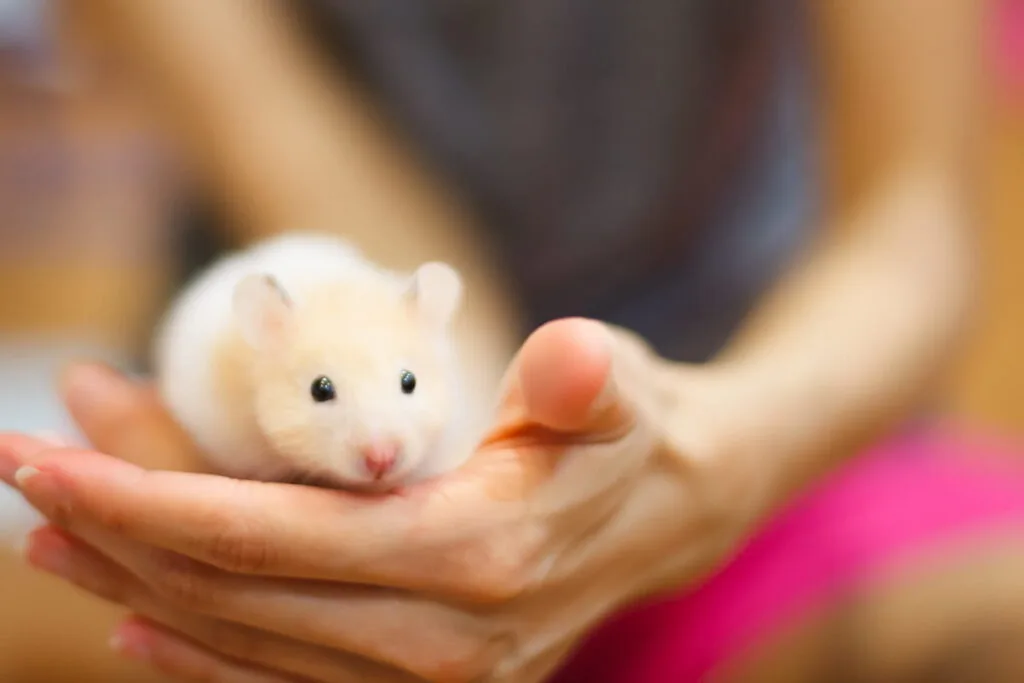
Caring For Your Hamster’s Health
Just keeping an eye on your hamster is a good way to make sure it’s healthy. If you notice any of the following, take your hamster to your veterinarian to get checked out:
- Low energy
- A wet bottom and droopy tail
- A cough or runny nose
- Unusual stiffness or difficulty moving
- Bald spots or sores
Though it’s good to be vigilant, hamsters are sturdy little critters. Following the advice above about their habitats and diet should mitigate most of these potential issues.
Breeding Your Hamster
Choosing to breed your hamster is a big step. Just because they can breed easily and quickly doesn’t mean that the decision to do so should be taken lightly.
Well, at least one part is pretty obvious. Put one male and one female together when the female hamster is in heat. They’ll sort it out, right?
Not really. It’s important to remember that you can’t just grab two random hamsters and let them mate.
Ask yourself the following things before you start:
Why do I want to breed my hamsters?
Since breeding your hamsters can put your pet’s life in danger, you should have a good reason to breed them.
Is this something that you’d like to do as a hobby, or do you see it as something for financial gain? If you just want more hamsters, why is breeding better than adoption in your case?
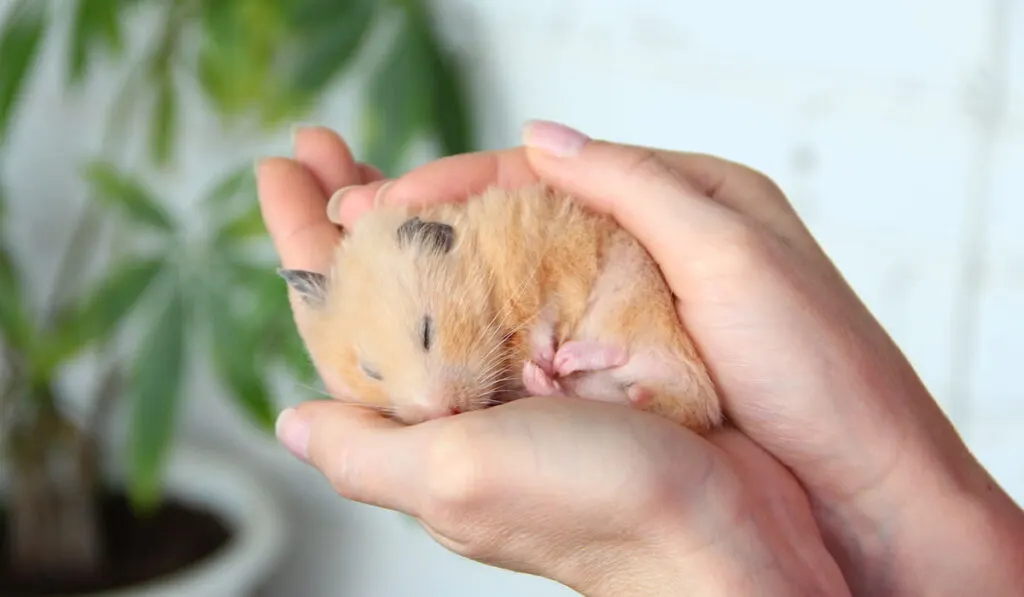
Make sure you’re clear on your motivations before you start.
Are the hamsters I want to breed related?
Again, this seems obvious but needs to be mentioned. Breeding hamsters that are closely related will likely lead to birth defects.
Is my female hamster in heat?
Teddy bear hamsters are territorial, so putting a male and a female together when the female isn’t in heat will likely end in violence. You can tell when your female hamster is in heat if she’s more active and if she flattens her body and raises her tail when you pet her back. She’ll also have a strong scent.
Females are in heat every four days. If she is, let them mate in the early evening, which is usually when mating happens in the wild. It usually takes at least twenty minutes for the deed to be done.
Can I care for a pregnant hamster?
Pregnant hamsters require a little extra care. You might not notice she is until her belly and sides start to grow, around nine or ten days in. Make sure she has a little extra protein, a lot of bedding to build a nest, and avoid picking her up as much as you can.
She can handle the birthing process, so don’t intervene.
How do I handle hamster pups?
Don’t touch them until they’re two weeks old, even if you’re tempted to. Doing so might make her abandon her pups.
The pups just need space to explore and eventually gain independence, which should be easy if you’ve set up the mother hamster’s living space properly.
Can I find good homes for all the pups?
Syrian hamsters usually have between six and ten babies, which means you’ll need to up your supplies and time spent with your pets. Unless you have a lot of space on your hands, you’ll likely need to give several of the pups away for adoption.
Be responsible and find homes with responsible owners who have demonstrated that they can care for hamsters.
Can I handle any problems that come up?
Although hamsters can breed with little to no intervention doesn’t mean that problems won’t arise. The mother might have an issue with the birth, or some pups might need medical attention. These things can be expensive.
Think about whether you’ll be able to handle problems emotionally as well. Seeing a pet that you’ve bonded to in pain or potentially losing them is a very real possibility.
Just get informed – gather as much information on hamster breeding as possible so that you know what you’re really getting into.
Final Thoughts
If you do your research, your teddy bear hamster can live in paradise. A happy hamster can be hours of entertainment for you and your family.
Resources:
- https://www.thesprucepets.com/syrian-hamsters-1238953
- https://petopedia.petscorner.co.uk/syrian-hamsters/
- http://dwarfhamsterhome.com/syrian-hamster/
- https://harveyhams.weebly.com/syrian-hamster-varieties.html
- https://www.petmd.com/exotic/care/evr_ex_hm_how-long-do-hamsters-live
- https://thehamsterhouse.com/hamster-food/what-do-hamsters-eat/
- https://animals.mom.me/dangers-hamster-wheels-3228.html
- https://hamsters101.com/hamster-tunnels/
- http://hamsterific.com/syrian-teddy-bear-hamsters/breeding-syrian-hamsters/
- https://thehamsterhouse.com/hamster-info/breeding-hamsters/what-is-the-hamster-gestation-period/
- http://hamsterific.com/hamsterific-university/hamster-breeding-basics/
